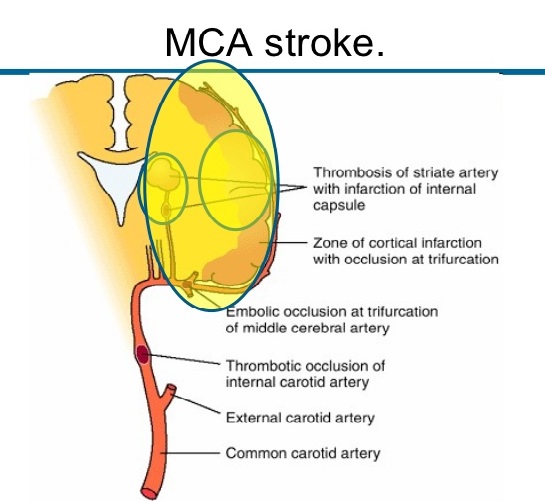There are there major arteries which transport clean blood and nutrients to the brain. The largest of these is the middle cerebral artery (MCA). Branching off the internal carotid artery, it provides blood to the side sections of the temporal, frontal and parietal lobes. These areas of the brain regulate the functions of the face, hands, throat and arms. The location where this large artery runs off the internal carotid artery is the most common site for a blockage, which can lead to a middle cerebral artery stroke.
Causes and Risk Factors for Middle Cerebral Artery Stroke
A middle cerebral artery stroke happens when the artery or one of its branches is blocked and blood cannot flow properly. When blocked, life sustaining substances such as blood, nutrients and oxygen cannot reach the brain. If the blockage is not cleared right away, permanent damage can occur.
There are several reasons a person can suffer from a middle cerebral artery stroke but some risk factors include smoking, diabetes, hypertension and atrial fibrillation. There are also conditions which increase a body’s chances of forming blood clots. Strokes commonly occur when a blood clot travels from an artery or the heart and gets lodged in the MCA. Sometimes, though less common, a blood clot will develop straight in the artery. In either case, the result is a middle cerebral artery stroke.
Symptoms of Middle Cerebral Artery Stroke

The middle cerebral artery divides, forming two separate arteries – the right middle and the left middle arteries. The right middle cerebral artery delivers blood to the right part of the brain, while the left artery transports blood to the left side. Depending on which side of the brain is affected will determine what kind of damage is done. Funny thing is, if the right artery is affected, then you will see symptoms on the left side of your body and vice versa.
1. Motor Symptoms
When a complete blockage occurs on one side of the middle cerebral artery, the paralysis effects of the stroke will be seen on an entire side of your face. If it is a partial blockage, only some areas will be affected and your face will show no signs. In this case, symptoms will be seen in an arm or leg. Over a period of time, individuals often see improvement and can regain a lot of their function back.
2. Sensory Symptoms
When you experience a middle cerebral artery stroke, a sensory strip found in the temporal lobe is often affected. This causes diminished sensation in some parts of the body like the neck, arm and face or sometimes an entire side of the body.
3. Visual Symptoms
During a stroke, your vision can be affected and loss of sight can occur. Your visual field is impaired, leading to partial or full loss. Sometimes, you lose control of movement of your eyes, making it hard to look in the direction you want to.
4. Speech Problems
When the left side of your brain is affected by a middle cerebral artery stroke, it can affect your ability to speak. You can lose your entire ability to speak or you can speak clearly but what you say makes no sense. In either case, it can cause you extreme distress but it is important to note this symptom often improves and you can completely recover depending on the severity of your condition.
Diagnosing Middle Cerebral Artery Stroke
Your doctor will order a number of tests to determine if you suffered a middle cerebral artery stroke and if so, which areas of your brain were affected.
- CT scan is done in the case of an emergency. It can quickly identify the site of the blockage and the extent of the damage.
- MRI is not commonly used but can help if the area afflicted is in the brainstem.
- Ultrasounds assist in assessment of artery damage.
- Various radiological tests are helpful in determining if a vascular condition is causing the blockage. Sometimes when a probe is used to search for damage, it can be used to fix the problem. In addition, tests are usually ordered to assess any damage to the heart that will result in high blood pressure or heart disease.
Treating Middle Cerebral Artery Stroke
Treatment is largely determined by the amount of time that has passed since the start of the stroke.
- If it is early on and there is no evidence of bleeding, an intravenous medication can be used to break up the blockage or clot that is causing the middle cerebral artery stroke.
- If it is more than a few hours since the start of the stroke, but fewer than 6 hours, there are wire devices and specific types of catheters which can be used to remove the clot. There is also a different type of intravenous treatment which can be administered.
- If there is swelling of the brain, surgery may be needed. Known as a craniectomy, the bone covering the brain tissue affected by the inflammation is removed to relieve pressure. This averts the swelling from moving inward so it does not damage the brainstem and other vital brain tissue.
